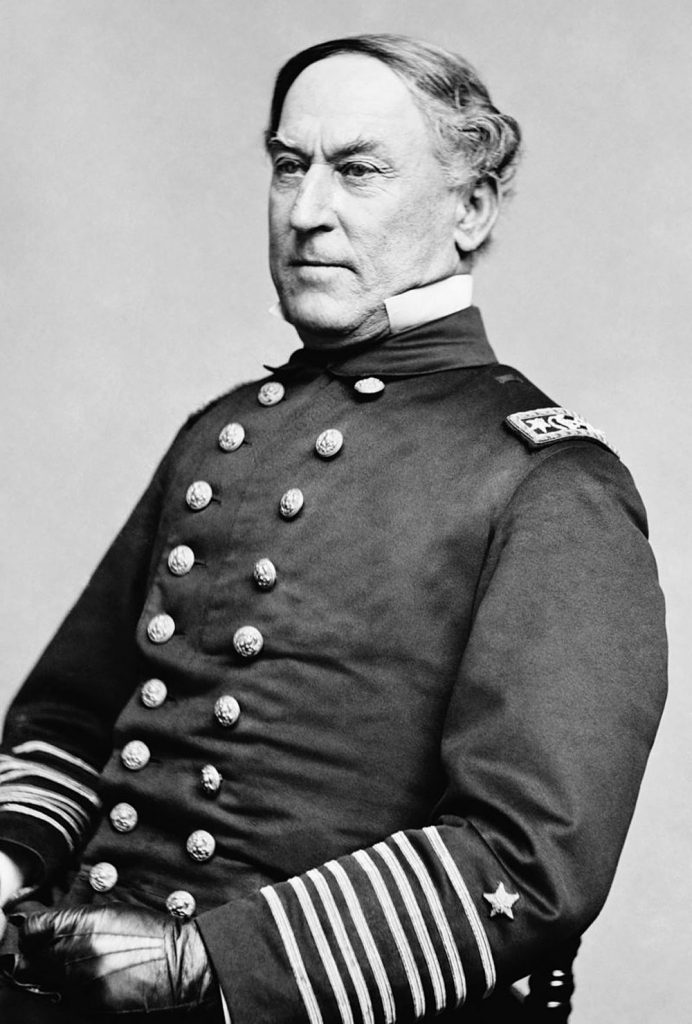
David Glasgow Farragut, born July 5, 1801, is an important American hero who devoted his life to service in the United States Navy. He holds the distinction of the first man to be awarded the titles of rear admiral, vice admiral and full admiral of the U.S. Navy during his lifetime. He is also remembered for his famous cry “Damn the torpedoes – full speed ahead”, at the Battle of Mobile Bay, Alabama.
Farragut’s father, Jorge Farragut-Mesquida, was a Spanish immigrant and a Revolutionary War hero. His mother, Elizabeth Shine, of Scots-Irish descent, was a native of North Carolina. After the end of the war, Jorge Farragut moved his family to Tennessee and in 1805 took a position at the port of New Orleans. He went on ahead of his family, who followed shortly after, giving young David his first voyage, on a river flatboat at age four to join his father in New Orleans.

Unfortunately, David’s mother died from yellow fever while living in New Orleans and her husband, feeling unable to care for his young children, sent them to live with family and friends. David was sent in 1808 to live with David Porter, a friend and naval officer who had served with Jorge. David, whose birth name was actually James, took the name of David in 1812 to honor his foster parent. David grew up in a naval family, his foster brothers being Admiral David Dixon Porter and Commander William O. Porter. He was adopted by Porter in 1810 and never saw his biological father again.
In 1810 David Porter arranged to take young David Farragut to sea with him. David was only 9 years old when he became a midshipman. He would serve the U.S. Navy for 60 years, until his death at age 69, commanding ships in several wars, including the American Civil War, and winning several decisive naval battles.
When the War of 1812 began, Farragut was a nine-year-old midshipman. By age 12 he was under the command of Captain David Porter aboard the USS Essex.
At first the Essex patrolled South American waters, but soon sailed north to join the fighting. Farragut was given his first command when the Essex captured the HMS Alert and he was ordered to bring that ship into port. Captain Porter had been very impressed by young David’s cool head and leadership skills during the battle.
After the end of the war, he served with U.S. fleets in the Mediterranean and Caribbean, chasing and capturing pirates. He achieved the level of lieutenant at this time and was awarded command of his first naval vessel, the USS Ferret in 1824. In the 1850s, Farragut was promoted to captain and helped to establish the first Naval Shipyard on the west coast at California’s Mare Island. It was the port for ship repairs on the west coast. On July 16, 1958 Farragut received a hero’s welcome there.
When the Civil War began, Farragut could have retired, but chose to keep serving his country. He was living in Norfolk, Virginia at the time, since his second wife and mother of his only child, a son, Loyall, was a Virginia native. Farragut did not want his allegiance to the Union questioned and spoke of succession as treason. He moved his family to Hastings-on-Hudson, New York. Not many realized that he considered himself a Southerner by birth but gave up his belongings and home to remain loyal to the Union. Some still questioned his loyalty and he was denied a command during the first half of the war.
In February 1962 he was given secret instructions to command the Gulf Blockading Squad and sailed on the USS Hartford, his 25-gun flagship. His fleet of 17 ships totaled 100 heavy guns and 700 men. They were met by 16 Confederate gunboats outside the city of New Orleans. The battle lasted two days and Union forces eventually captured both the city and the port of New Orleans. This led to Farragut’s being awarded the rank of rear admiral on July 16, a rank never before used in the United States Navy.
At the time, the U.S. Navy favored the term “flag officer” rather than admiral, which was seen as a European designation for royalty.
Next Farragut suffered great damage to his ships at the Siege of Port Hudson, on the Mississippi. This was mostly his fault for not following the agreed-upon tactics and moving on his own. No reprimand was issued. On July 4, 1863 the city of Vicksburg surrendered and on July 9 Port Hudson followed. The Union forces now had achieved their plan, to cut the Confederacy in half by controlling the Mississippi River.
In his most famous battle, the Battle of Mobile Bay, Alabama, August 5, 1964, Farragut was victorious in bringing the last major open port in the Gulf of Mexico under Union command. The bay had been heavily mined and after seeing one ship blown up, others started to withdraw. When Farragut asked what the trouble was, he was informed that the bay was mined. This is when he uttered his famous motto “Damn the torpedoes…….” In December President Lincoln promoted Farragut to vice admiral, again the first officer to be awarded that rank.
David Farragut became the first U.S. Naval officer to hold the rank of full admiral, when he was given that title on July 25, 1866. He was also made a Companion of the First Class of Military Order of the Loyal Legion of the United States. His last active service was command of the European Squadron from 1867-1868. The USS Franklin served as his flagship. Farragut remained on active service for life.
David Farragut died from a heart attack on August 14, 1870 while on vacation in New Hampshire, still commanding the U.S. Navy. He is buried in Woodlawn Cemetery in the Bronx, NY, his gravesite on the National Registry of Historic Places. A 2-mile parade of 10, 000 soldiers, sailors, politicians and even President Ulysses Grant, accompanied his coffin to the gravesite. There are statues of him in New York City and Washington D.C. Two classes of destroyers were named after him, in 1934 and 1958. His likeness appeared on a $100 U.S. Treasury note in 1891 and he has been honored with his face on several U.S. stamps – the $1 in 1903, a 3-cent purple stamp in 1937, which also includes David Porter’s face, and one issued in 1995.
